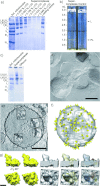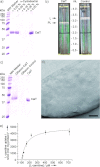GRecon: a method for the lipid reconstitution of membrane proteins
- PMID: 22821803
- PMCID: PMC3494379
- DOI: 10.1002/anie.201202094
GRecon: a method for the lipid reconstitution of membrane proteins
Figures



References
-
- Kastner B, Fischer N, Golas MM, Sander B, Dube P, Boehringer D, Hartmuth K, Deckert J, Hauer F, Wolf E, Uchtenhagen H, Urlaub H, Herzog F, Peters JM, Poerschke D, Lührmann R, Stark H. Nat. Methods. 2008;5:53–55. - PubMed
-
- Overington JP, Al-Lazikani B, Hopkins AL. Nat. Rev. Drug Discovery. 2006;5:993–996. - PubMed
-
- Rigaud JL, Levy D. Methods Enzymol. 2003;372:65–86. - PubMed
-
- Rigaud JL, Levy D, Mosser G, Lambert O. Eur. Biophys. J. Biophys. Lett. 1998;27:305–319.
MeSH terms
Substances
LinkOut - more resources
Full Text Sources
Other Literature Sources

